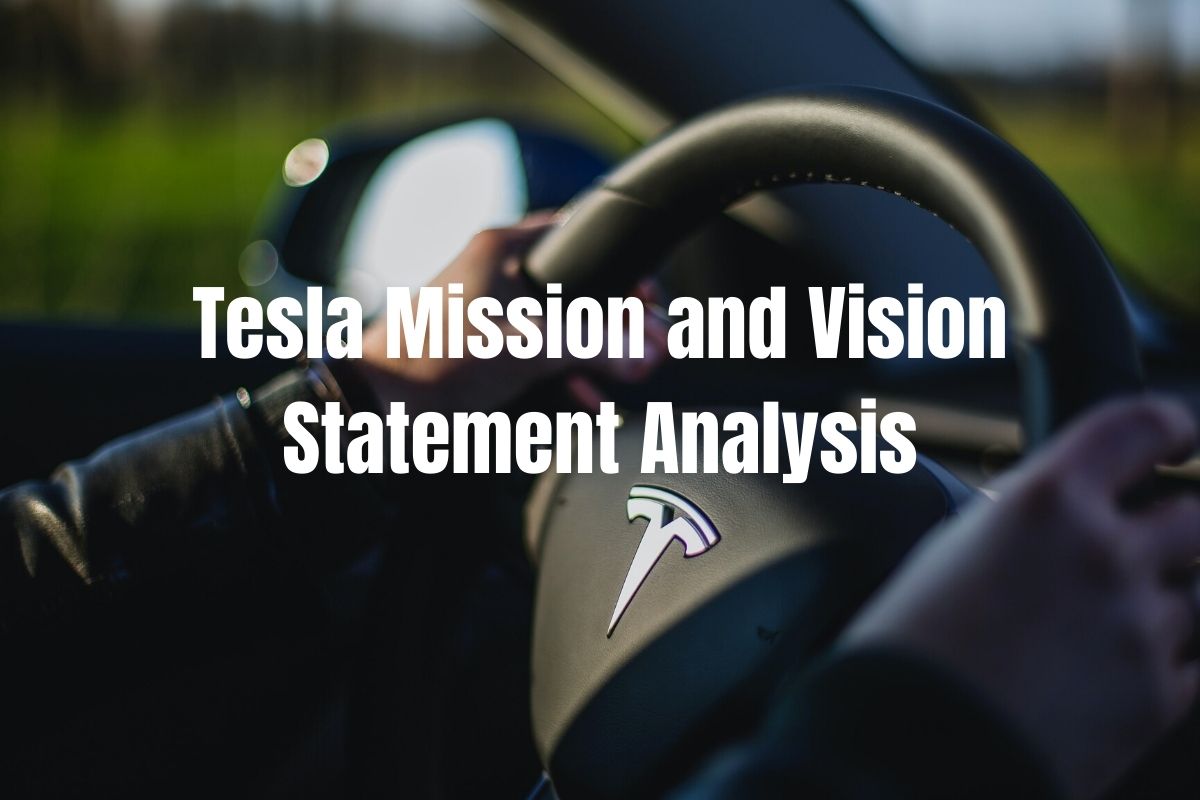Tesla Mission and Vision Statement Analysis

Introduction
The nature of Tesla, Inc.'s notable all-electric automotive manufacturing and associated industries is reflected in its goal and vision statements. The firm, which was founded in 2003, became profitable in 2013. The market is reacting to the company's automotive and energy storage solutions, as seen by its continued expansion. This circumstance emphasizes the company's mission statement's suitability. The corporate mission statement, in essence, directs Tesla's strategic decisions, such as what the firm must undertake to achieve business effectiveness.
The accompanying corporate vision statement, on the other hand, directs Tesla's organizational growth. For example, as a worldwide automotive corporation focused on electric vehicles, the firm aspires to be the best. The firm is well-positioned to thrive in the global electric vehicle industry, with a strong brand image and growing popularity. Tesla's operational success and business development are measured by how satisfied employees are with the company's goal and vision.
Tesla, Inc. sticks to its company vision and purpose statements, focusing on electric cars and related goods, including solar panels and rechargeable battery packs for cars as well as other purposes. However, recent market and commercial shifts have forced the corporation to update its corporate mission statement while leaving the corporate vision statement in place for the time being. These developments are reflected in current strategy and managerial activities. For example, Tesla's marketing mix (4Ps) stresses the company's desired role as a key participant in the renewable and sustainable energy sector.
Mission Statement
"To speed the world's transition to sustainable transportation," Tesla's mission statement stated. However, under Elon Musk's leadership, the business's objective was altered to "accelerate the expansion of sustainable and renewable energy" in mid-2016. This new statement denotes a little but important adjustment in the company's business strategy to capitalize on renewable energy market potential.
In some ways, the new corporate goal acknowledges the company's batteries and related energy storage technologies' value in industries other than the electric car industry. The following are key components of Tesla Inc.'s mission statement:
- To speed up the world's transformation
- In the direction of renewable energy
Tesla's position in driving the industry forward to innovative technologies for sustainable business and goods that rely on renewable energy is established by the "to advance" component of the company mission statement. The company's business objective also cites "the world's transformation," implying that it expects to dominate the worldwide demand for electric vehicles and related items. This element is linked to the emphasis on the global market in the business vision statement. Furthermore, the shift from "sustainable transportation" to "sustainable energy" demonstrates how Tesla, Inc.'s corporate mission statement changes to reflect the company's current strategic goals.
Vision Statement
"To become the most attractive automobile company of the twenty-first century by spearheading the world's shift to electric vehicles," says Tesla's vision statement. The business's emphasis on renewable energy is emphasized in its business goal. The organization specifically tackles the electric vehicle sector as a primary channel for aiding worldwide renewable energy market growth. In Tesla Inc.'s vision statement, the following elements are important:
- The most intriguing automobile company of the twenty-first century
- The shift to electric automobiles throughout the world
According to its corporate vision statement, Tesla, Inc. aspires to be the most compelling company in the business. This component denotes corporate leadership and excellence. This goal is achieved by incorporating innovative technology into the company's electric vehicles and related goods. The "car company" element of the business strategy, on the other hand, focuses Tesla Inc.'s efforts on developing and producing automobiles.
The "21st-century" component is satisfied by the company's management in electric vehicle development and manufacturing. This element denotes the company's utilization of cutting-edge technologies to deliver contemporary issues such as environmental conservation. The fourth component refers to the company's long-term objectives. The company, for example, is continuing to expand its operations, with plans for additional plants in Asia's emerging regions. Considering the competitive environment depicted in Tesla Inc.'s Porter's Five Forces analysis, such expansion addresses significant competitors. The company's vision statement displays the organization's goal to be the dominating player in the worldwide electric car industry in this business research case.
Core Values
"Doing the best, taking chances, respect, continuous learning, and environmental responsibility" are among Tesla's basic principles. Tesla uses these core values as the guiding principles for all partners' and employees' general behavioral patterns.
Tesla has advanced technologically as a result of its concentration on performance, while the firm also pushes its staff to take measured risks while driving breakthroughs. Furthermore, Tesla's achievement has a lot to do about the corporation's promotion of respect among the many players who have come into touch with the organization. This type of atmosphere promotes everyone's overall learning, which results in outcomes that are in line with Tesla's environmental protection standards.
Tesla Mission and Vision Statement Analysis Mind Map
Tesla Inc. is a firm that has pushed the automobile industry's advancements to the next degree. Its purpose and vision statements underline the company's commitment to ushering in a new age of electric vehicles, which it deems to be more dependable, efficient, and environmentally friendly. Tesla's mission and vision statements have evolved to reflect the company's plan of transitioning to the production of electric vehicles rather than gasoline-powered vehicles.
Key Takeaways
In terms of describing the company's aims, Tesla, Inc.'s mission statement is adequate. It appropriately covers the types of items that the firm offers, the extent of the company's market, and the company's market position. It does not, however, give complete information regarding Tesla's overall organizational growth. As a result, the corporate purpose must be improved by incorporating additional specifics about the company's efforts to achieve its corporate vision.
The vision statement of Tesla Inc. accurately expresses the company's goals. It does not, therefore, include ongoing commercial ventures. While the company's mission statement has already been updated to include "renewable energy," the company's vision continues to focus on "electric cars." In this regard, it is suggested that Tesla Inc.'s vision statement be adjusted to reflect the company's growing interest in goods other than electric automobiles.
The Tesla mission and vision statement analysis mind map gives us a better way of understanding the mission, vision, and all the core values of the company in the best way possible. With that sentiment, making a mind map for your learning purposes can also work the same way. Learning with mind maps has been known to help in remembering things. To make it easier, EdrawMind is offering a lot of free built-in templates for everyone to choose and edit.

 below.
below.  below.
below. 





